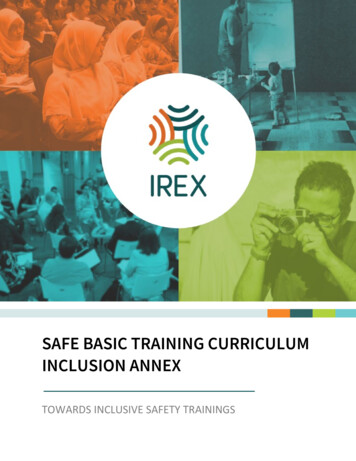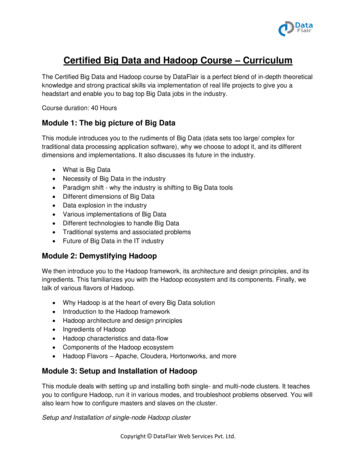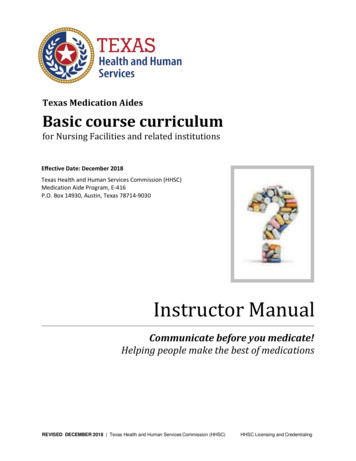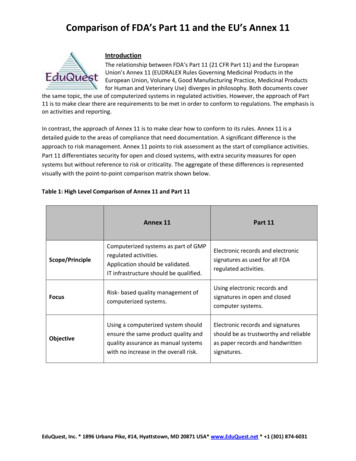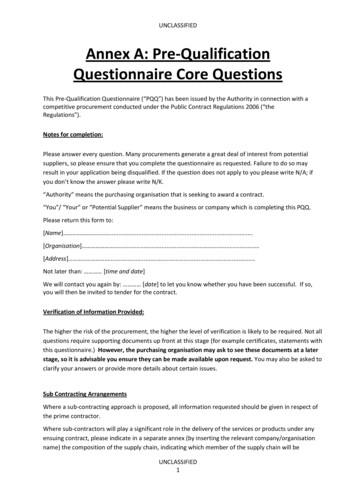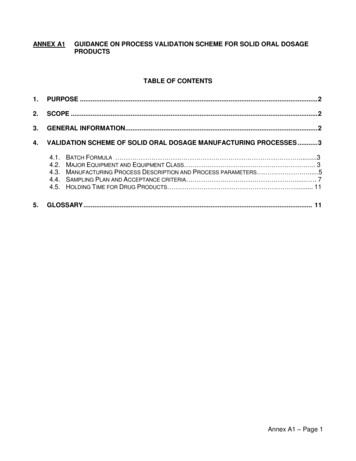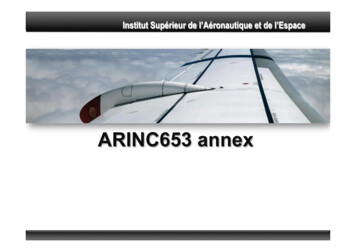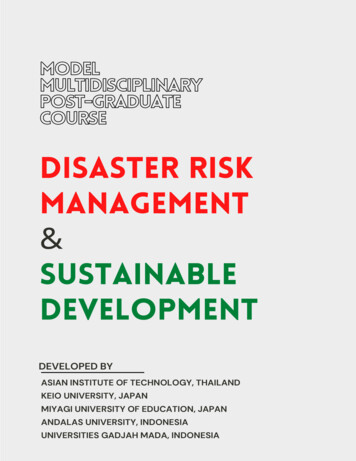
Transcription
&DEVELOPED BYASIAN INSTITUTE OF TECHNOLOGY, THAILANDKEIO UNIVERSITY, JAPANMIYAGI UNIVERSITY OF EDUCATION, JAPANANDALAS UNIVERSITY, INDONESIAUNIVERSITIES GADJAH MADA, INDONESIA1
Model Multidisciplinary Post Graduate CourseDisaster Management and Sustainable DevelopmentCurriculum Development CommitteeDr. Indrajit Pal, Asian Institute of Technology, ThailandProf. Sangam Shrestha, Asian Institute of Technology, ThailandProf. Rajib Shaw, Keio University, JapanDr. Dyah R. Hizbaron, Universities Gadjah Mada, IndonesiaProf. Tomonori Ichinose, Miyagi University of Education, JapanDr. Takashi Oda, Miyagi University of Education, JapanProf. Yon Yonariza, Andalas University, IndonesiaAssociateGanesh Dhungana, Asian Institute of Technology, ThailandThe development of this course curriculum is supported by the ProSPER.Net consortium project"Disaster Education for Integrating SFDRR and SDG in Asia" lead by the Asian Institution ofTechnology, Thailand in coordination with Keio University, Japan; Miyagi University of Education,Japan; Andalas University, Indonesia; and Universitas Gadjah Mada, Indonesia.2
PrefaceThe designed post-graduate courses provide a comprehensive foundation for individuals tounderstand Disaster Risk Reduction and Sustainable Development. Most importantly, thesemodel courses support producing a qualified human resource for government agencies, intergovernmental organizations, national and international non-governmental organizations, privatesectors, and academic institutions for effective program planning and management in disasterresilience and sustainability.The courses offered in this program are developed through an intensive discussion betweenrepresentatives and experts of collaborating institutions. To formalize and have coherence in thecurriculum and the course's pedagogy, all partnering universities proposed the courses with theirexpertise developed in a standard curriculum format. To validate the efficiency of the designedmodule, a two-week concise version of the certificate course was designed based on thedeveloped curriculum. The introductory certificate course was offered to thirty-five postgraduate and doctoral students from nine countries of the Asian region.3
Table of ContentsConcepts and theoriesMC O1: Disaster Management Fundamentals .6MC O2: Community Based Disaster Management .9MC 03: Disaster Governance . 11MC 04: Humanitarian Governance . 13Innovations, Tools and TechnologiesMC 05: Disaster Risk Assessment . 17MC 06: Science, Technology and Disaster Risk Reduction. 19MC 07: Image-based Spatial Modeling for Disaster Management . 21MC 08: Coastal and Watershed Resources and Hazard Modeling . 24Management and SustainabilityMC 09: Disaster Risk Reduction and Mitigation. 29MC 10: Disaster Recovery . 32MC 11: Disaster Management and Humanitarian Response . 35MC 12: Multidisciplinary Approach for Disaster Management and Sustainability. 37Cross Cutting Areas and IssuesMC 13: Media and Disaster Risk Reduction . 40MC 14: International Relation and Disaster Diplomacy . 42MC 15: Disaster Education . 42MC 16: Social Inclusion in Disaster Management . 484
DISASTER MANAGEMENT FUNDAMENTALSCOMMUNITY BASED DISASTER MANAGEMENTDISASTER GOVERNANCEHUMANITARIAN GOVERNANCE5
Concepts and theoriesMC O1: Disaster Management FundamentalsCourse ObjectivesThe course provides a fundamental understanding of basic concepts and elements of disaster.The course aims to develop conceptual clarity about the different elements of disaster andenhance students' knowledge about the types of disaster, the management process, and itscomplete cycle. This course serves as an introductory course for those coming from diversebackgrounds. Holistically, this course contributes to reducing the potential losses from hazardsand supports providing required assistance to disaster-affected populations by sensitizingstakeholders and policymakers about the appropriate steps to be taken. The course offers ahyperlink to other core thematic areas associated with Disaster Risk Reduction and DisasterManagement and helps students in selecting the interest areas within the academic domain ofDisaster Management.Learning OutcomesUpon successful completion of this course, the students will be able to: Have a conceptual understanding of the terms and terminologies used in DisasterManagement Contribute to disaster risk reduction and management Understand key associated thematic areas within disaster managementCourse OutlinesActivity and assignment details are explained in detail within each week's correspondinglearning module.Week 01: Key Terminologies in Disaster Management Hazards Vulnerability Capacity Resilience RiskWeek 02: Elements of Disaster Mitigation Preparedness Response RecoveryWeek 03: Thematic Areas of Disaster Management Disaster risk reduction Theories6
PracticesDisaster governance Legislation Economic Administration Risk communicationCrises managementWeek 04: Approaches in Disaster Management Community-based approach Engineering-based approach Incident command system approach Environmental approachesWeek 05: Comprehensive Disaster Management Social integration in disaster management Tools and technologies in disaster management Cross-cutting issues in disaster management Development phenomena and disaster managementLaboratory Session (s)There would be group discussion and group presentations. Group discussion topics will beallocated during the course.Reference Reading Carter, W. N. (2008). Disaster management: A disaster manager's handbook. Coppola, D. P. (2006). Introduction to international disaster management. Elsevier. Gupta, A. K., Nair, S. S., Wajih, S. A., Chopde, S., Gupta, G., & Aggrawal, G. (2014).Mainstreaming Climate Change Adaptation and Disaster Risk Reduction into DistrictLevel Development Plans. NIDM New Delhi (India), GEAG Gorakhpur (UP, India) andISET, Colorado (US), P, 114. Khan, H., Vasilescu, L. G., & Khan, A. (2008). Disaster management cycle-a theoreticalapproach. Journal of Management and Marketing, 6(1), 43-50. Nojavan, M., Salehi, E., & Omidvar, B. (2018). Conceptual change of disastermanagement models: A thematic analysis. Jàmbá: Journal of Disaster RiskStudies, 10(1), 1-11. Pearce, L. (2003). Disaster management and community planning, and publicparticipation: how to achieve sustainable hazard mitigation. Natural hazards, 28(2),211-228. Schipper, L., & Pelling, M. (2006). Disaster risk, climate change and internationaldevelopment: scope for, and challenges to, integration. Disasters, 30(1), 19-38. Stenchion, P. (1997). Development and disaster management. Australian Journal ofEmergency Management, The, 12(3), 40-44.7
Teaching and Learning Methods:Blended: In-Person and Online, Classroom lectures, Assignment, Case Study, Group discussion,and presentation.Time Distribution and Study Load: Lectures: 50% Self-study: 30% Assignment, presentations, and group activities: 20%8
MC O2: Community Based Disaster ManagementCourse ObjectivesThe course will help to enhance the understanding of managing the disaster at a communitylevel. The course provides a process to engage with communities for disaster risk reductionand management and provides basic principles of community-based disaster managementapproaches. The course discusses stakeholder analysis, vulnerability and resource assessment,participatory methodologies as essential tools required for localizing the disaster managementprocess. Students will also have fundamental knowledge about risk reduction, programimplementation, issue-based advocacy as an important aspect of communities in the disastermanagement cycle.Learning OutcomesUpon successful completion of this course, the students will be able to: Have an understanding about the community-based disaster management approach Conduct Stakeholder analysis, vulnerability, and resource assessment Understand community-based program implementation methodology Evaluate the strategies and frameworks for community-based disaster risk reductionCourse OutlinesActivity and assignment details are explained in detail within each week's correspondinglearning module.Week 01: Concept and Theory Concept of CBDM Principles of CBDM Stages in CBDMWeek 02: Participatory Approaches in CBDM Tools and techniques Community-led risk assessment Community-based risk reduction plan Community based monitoring approaches Assessment methods and toolsWeek 03: Risk Management Plan Community-based disaster preparedness and management plan Resource mapping Local committees, Taskforces, and emergency directoryWeek 04: Community Risk Profile (Project Work) Selection of a community9
Demographic InformationIdentification of possible hazardsRisk Attributes & VulnerabilityHazard RankingWeek 05: Community-Based Innovations Case studies of DRR initiatives Local knowledge and practices in DRRLaboratory Session (s)Week 04 will be conducted in the field; students will be divided into several groups, and eachgroup will produce a risk profile of a community.Reference Reading Ardaya, A. B., Evers, M., & Ribbe, L. (2019). Participatory approaches for disaster riskgovernance? Exploring participatory mechanisms and mapping to close thecommunication gap between population living in flood risk areas and authorities inNova Friburgo Municipality, RJ, Brazil. Land Use Policy, 88, 104103. Center, A. D. P., & ESCAP, U. (2004). Community-based disaster risk management:field practitioners' handbook. Larsen, O., Oliver, J., & Casiles Lanuza, E. (2014). Developing a disaster risk insuranceframework for vulnerable communities in Pakistan: Pakistan disaster risk profile. Luna, E. M. (2014). Community-based disaster risk reduction and disastermanagement. Disaster management: International lessons in risk reduction, responseand recovery, 43-63. Shaw, R. (Ed.). (2012). Community based disaster risk reduction. Emerald GroupPublishing. Van Niekerk, D., Nemakonde, L. D., Kruger, L., & Forbes-Genade, K. (2018).Community-based disaster risk management. In Handbook of disaster research (pp.411-429). Springer, Cham. zumi, T., Shaw, R., Djalante, R., Ishiwatari, M., & Komino, T. (2019). Disaster riskreduction and innovations. Progress in Disaster Science, 2, 100033.Teaching and Learning MethodsBlended: In-Person and Online, Classroom lectures, Assignment, Case Study, Group discussionand presentation.Time Distribution and Study Load Lectures: 50% Self-study: 30% Assignment, presentations, and group activities: 20%10
MC 03: Disaster GovernanceCourse ObjectivesDisaster governance is an emerging subject in disaster risk reduction and management. It is acomprehensive idea that discusses the legislative, administrative, and economic functions inmanaging a disaster. Disaster governance provides a systematic integration of DRR concernsinto all relevant development spheres and approaches that are well-coordinated and efficientfor long-term sustainability. This course aims to provide an understanding of major anddeveloping challenges and perspectives on current disaster trends and the efficient way ofgoverning them.Learning OutcomesUpon successful completion of this course, the students will be able to: Understand concepts of disaster governance Update on legal and structural provisions at national and regional level Update on global commitments and initiations on DRR Analyze key challenges in mainstreaming DRR at the national and local levels.Course OutlinesActivity and assignment details are explained in detail within each week's correspondinglearning module.Week 01: Concept and theory Concept of disaster governance Definition and scopes of disaster governance Components of disaster governanceWeek 02: Basic components of disaster governance Legislative function Structural provisions Financial mechanism Multi-layer coordinationWeek 03: DM Cycle and Governance Legal provision and mandates for preparedness and mitigation Disaster response governance Leadership and requisite frameworks for reconstructionWeek 04: Introduction of global frameworks Hyogo framework Sendai framework Sustainable Development Goals11
The Paris AgreementWeek 05: Emerging components of disaster governance Social sensitivity Disaster diplomacy Regional and international alliancesLaboratory Session (s)There would be group discussions and group presentations. Group discussion topics will beallocated during the course.Reference Reading Aitsi-Selmi, A., Egawa, S., Sasaki, H., Wannous, C., & Murray, V. (2015). The Sendaiframework for disaster risk reduction: Renewing the global commitment to people'sresilience, health, and well-being. International journal of disaster risk science, 6(2),164-176. Goyal, N. (2019). Disaster governance and community resilience: The law and the roleof SDMAs. International Journal of Disaster Risk Management, 1(2), 61-75. Kapucu, N., & Sadiq, A. A. (2016). Disaster policies and governance: Promotingcommunity resilience. Kelman, I. (2017). Linking disaster risk reduction, climate change, and the sustainabledevelopment goals. Disaster Prevention and Management: An International Journal Miller, M. A., & Douglass, M. (Eds.). (2015). Disaster governance in urbanizing Asia.Springer. Pal, I., & Shaw, R. (Eds.). (2018). Disaster risk governance in India and cross cuttingissues. Springer Singapore. Tierney, K. (2012). Disaster governance: Social, political, and economicdimensions. Annual Review of Environment and Resources, 37, 341-363Teaching and Learning MethodsBlended: In-Person and OnlineClassroom lectures, Assignments, Case Study, Group discussions and presentation.Time Distribution and Study Load Lectures: 50% Self-study: 30% Assignment, presentations, and group activities: 20%12
MC 04: Humanitarian GovernanceCourse ObjectivesThe impact of disasters is increasing, and the need for humanitarian assistance is in highdemand. One of the prime concerns in humanitarian governance is the dignity of disasteraffected communities and people. The course's main objective is to ensure that organizationsand individuals follow basic humanitarian principles while saving lives. Henceforth, the coursefocuses on humanitarian workers to enhance their capacity with professional competence toserve in preventing and alleviating human suffering without conflicting interests. The courseaims to provide a comprehensive understanding of principles, ethics, and key concerns ofhumanitarian services to those looking forward to contributing to serving society during crises.The course supports the humanitarian service providers to be grounded with local culture andtheir social context while delivering support during emergencies. The course also discussesethical deliberation during response and recovery in humanitarian settings that includes themoral responsibilities of an individual and organization while carrying professional duties. Thiscourse will support internalizing fundamental components crucial for humanitarianorganizations, funding agencies, inter-governmental organizations, and practitioners whiledelivering humanitarian services in a complex socio-political situation and economicallybackward countries.Learning OutcomesUpon successful completion of this course, the students will be able to: Have a comprehensive idea about the humanitarian service and Core HumanitarianStandards (CHS). Manage humanitarian assistance and support Understand international protocols, standards, and ethical considerations requiredfor humanitarian services Will be able to conduct rapid assessment and development response programs in anemergency context.Course OutlinesActivity and assignment details are explained in detail within each week's correspondinglearning module.Week 01: Definitions What is humanitarian governance? History and evolution of humanitarian assistance Basic principles of humanitarian governance Humanitarian organizationsWeek 02: Humanitarian organizations Nature and scope of humanitarian organizations13
Governmental Agencies Intergovernmental agencies Non-Government Organizations Religious organizationTypes of deliveries of services Search and Rescue Delivery of relief materials Medical Assistance Financial aidWeek 03: Humanitarian Standards Global commitments and humanitarian chatter Core Humanitarian Standards (CHS) Humanitarian ethicsWeek 04: Humanitarian Skill and Basic Requirement Consist mental, emotional, and physical balance Humanitarian technologies Expertise areas (medical assistance, search, and rescue, relief and support delivery,task forces, need assessment)Week 05: Humanitarian Service Delivery Understanding of cluster approach Key challenges in humanitarian logistic Adapting to context Quality assistance Leave no-one behind Multi–layer coordinationLaboratory Session (s)There would be group discussions and group presentations. Group discussion topics will beallocated during the course.Reference Reading Abdelmagid, N., Checchi, F., Garry, S., & Warsame, A. (2019). Defining, measuring, andinterpreting the appropriateness of humanitarian assistance. Journal of InternationalHumanitarian Action, 4(1), 1-13. Barnett, M. N. (2013). Humanitarian governance. Annual Review of PoliticalScience, 16, 379-398. Beigbeder, Y. (1991). The role and status of International Humanitarian Volunteersand Organizations: The right and duty to humanitarian assistance (Vol. 12). MartinusNijhoff Publishers.14
Daud, M. S. M., Hussein, M. Z. S. M., Nasir, M. E., Abdullah, R., Kassim, R., Suliman, M.S., & Salu-Din, M. R. (2016). Humanitarian logistics and its challenges: The literaturereview. International Journal of Supply Chain Management, 5(3), 107-110.Dijkzeul, D., & Sandvik, K. B. (2019). A world in turmoil: governing risk, establishingorder in humanitarian crises. Disasters, 43, S85-S108Hilhorst, D. (2015). Taking accountability to the next level. In On the road to Istanbul:How can the World Humanitarian Summit make humanitarian response moreeffective? (pp. 104-112). CHS Alliance.Larson, P. D., & Foropon, C. (2018). Process improvement in humanitarian operations:an organisational theory perspective. International Journal of ProductionResearch, 56(21), 6828-6841.Teaching and Learning MethodsBlended: In-Person and OnlineClassroom lectures, Assignments, Case Study, Group discussions and presentation.Time Distribution and Study Load Lectures: 50% Self-study: 30% Assignment, presentations, and group activities: 20%15
DISASTER RISK ASSESSMENTSCIENCE TECHNOLOGIES AND DISASTER RISKREDUCTIONSIMAGED BASED SPATIAL MODELING FORDISASTER MANAGEMENTCOSTAL WATERSHED AND HAZARD MODELING16
Innovations, Tools and TechnologiesMC 05: Disaster Risk AssessmentCourse ObjectivesDisaster directly impacts livelihood, property, infrastructure, services, and the environment.The possible damage is proportional to the vulnerability of the exposed areas. So, riskassessment plays an important role to understand it's intensity, so that actions can be takenaccordingly for its reduction and mitigation. The goal of this course is to provide perspectiveson recent advances in vulnerability and risk assessment methods, tools, and strategies.Students will also learn how to identify significant concerns and obstacles in vulnerability andrisk assessments, which will lead to evidence-based policy choices to manage risk.Learning OutcomesUpon successful completion of this course, the students will be able to: Have fundamental concepts of multiple hazards, vulnerability, and risk Will be able to develop indicators for risk assessment Can analyze risk to multiple hazards using different approachesCourse OutlinesActivity and assignment details are explained in detail within each week's correspondinglearning module.Week 01: Concept Basic concept of Disaster Risk Need of hazard, vulnerability, and risk assessment Introduction to geospatial data analysisWeek 02: Vulnerability Indicators Vulnerability indicators Socioeconomic indicators Physical infrastructure indicators Biophysical indicators Cultural-Natural heritage indicators Governance indicators Assessment methods and toolsWeek 03: Risk Assessment Understanding Risk Elements Risk mapping and analysis Risk information and decisionWeek 04: Use of tools and technologies (exercises and tutorial)17
Introduction of different tools and technologies QGIS Geospatial data analysisWeek 05: Use of tools and technologies (exercises and tutorial) Calculating vulnerability and risk indices Hazard-specific and multiple-hazard vulnerabilities and risks assessment Generate risk maps using qualitative and quantitative methods Statistical analysis for finalizing the indicatorsLaboratory Session (s)Week 04 and Week 05 will be conducted in the laboratory assigning a separate project toeach student.Reference Reading Birkmann, J. (2007). Risk and vulnerability indicators at different scales: Applicability,usefulness and policy implications. Environmental hazards, 7(1), 20-31. Dyke, G., Gill, S., Davies, R., Betorz, F., Andalsvik, Y., Cackler, J., . & Verstappen, N.(2011). Dream project: Applications of earth observations to disaster riskmanagement. Acta Astronautica, 68(1-2), 301-315. Manfré, L. A., Hirata, E., Silva, J. B., Shinohara, E. J., Giannotti, M. A., Larocca, A. P. C.,& Quintanilha, J. A. (2012). An analysis of geospatial technologies for risk and naturaldisaster management. ISPRS International Journal of Geo-Information, 1(2), 166-185. Marshall, T. M. (2020). Risk perception and safety culture: Tools for improving theimplementation of disaster risk reduction strategies. International journal of disasterrisk reduction, 47, 101557. Vatsa, K. S. (2004). Risk, vulnerability, and asset-based approach to disaster riskmanagement. International Journal of Sociology and Social PolicyTeaching and Learning MethodsBlended: In-Person and OnlineClassroom lectures, Assignments, Case Study, Group discussions and presentations.Time Distribution and Study Load Lectures: 50% Self-study: 30% Assignment, presentations, and group activities: 20%18
MC 06: Science, Technology and Disaster Risk ReductionCourse ObjectivesScience and Technology for disaster risk reduction has always been there in some form indifferent countries. Through the advancement of scientific research, disaster risk reduction hasbeen benefitted, especially in terms of early warning system, to identify risk in both spatial andtemporal scale, strengthening of buildings and infrastructures for different types of hazardsetc. In recent years, apart from hard science, which is more on innovations and engineering,soft science or social sciences have also got prominence and importance. This course exploresand analyzes already existing good examples of role of science and technology in four prioritiesof Sendai Framework for Disaster Risk Reduction (SFDRR) and suggest the way forward ofscience base decision making at different levels, with specific focus on Asia.Learning OutcomesUpon successful completion of this course, the students will be able to: Explain the evolution of science and technology in pre and post Sendai context Explain role of S/T in different SFDRR priorities Understand the policy perspective of S/T and its applicationCourse OutlinesActivity and assignment details are explained in detail within each week's correspondinglearning module.Week 01: Thirty years of evolution of S/T in DRR Importance of S/T Significant developments in science and technology Incorporation into the decision making in disaster risk reduction. New research and innovations.Week 02: Priority of action of S/T in post Sendai context Science and technology in post - Sendai Context Science and Technology for roadmap of UNISDR Priority actions of science and technology to accomplish the roadmap Multidisciplinary research in the field of disaster risk reductionWeek 03: S/T to enhance disaster resilience in changing climatic condition Climate variability and associated extremes Building resilience to future climate change Risks associated with climate change and variability in Asia and its implications Effective communication and inclusive risk-informed decision-making.19
Week 04: Investment in S/T Investing in DRR for resilience Role of stakeholders (local governments, the private sector, andacademia/universities) DRR investment based on natural and social-science research Structural and non-structural measures. DRR investment plans based on their specific situationsWeek 05: Emerging technologies and DRR Emerging technologies and its effects to enhance disaster resilience. Gaps, challenges, capacities for disaster management. Emerging technologies Cyber physical systems Geotechnology Drone VR/AR Technologies and decision support system.Laboratory Session (s)There would be group discussion and group presentations. Group discussion topics will beallocated during the course.Reference Reading Sakurai M. and Shaw R. (2021): Emerging technologies for disaster resilience: Practicalcases and theories, Springer, 260 pages. Shaw R. (2020): Thirty years of science and technology, and academia in disaster riskreduction and emerging responsibilities, in International Journal of Disaster RiskScience, https://doi.org/10.1007/s13753-020-00264-z Shaw R., Shiwaku K. and Izumi T. (2017): Science and technology in disaster riskreduction: Potentials and challenges, Elsevier Academic Press, 525 pages.Teaching and Learning Methods:Blended: In-Person and OnlineClassroom lectures, Assignment, Case Study, Group discussion and presentation.Time Distribution and Study Load: Lectures: 50% Self-study: 30% Assignment, presentations and group activities: 20%20
MC 07: Image-based Spatial Modeling for Disaster ManagementCourse ObjectivesThis course learns about the role of spatial data in dealing with disaster problems. For thispurpose, at the beginning of the lecture, students are given basic knowledge about theconcepts of disaster that are currently developing. In this concept, among others, the terms ofhazard, vulnerability, susceptibility, and element at risk are being distinguished. In addition tothese concepts, students were also explained about the disaster management cycle, where therole of spatial data in each cycle will be more specific.Learning OutcomesUpon successful completion of this course, the students will be able to: Able to explain the role of disasters as spatial, ecological, and regional phenomena, andrequired geospatial data to be managed properly Able to identify various types of disasters with various causal variables, as well asidentify types of geospatial data (images and maps), what kind of approaches used tomap various variables and their modeling Able to extract thematic information through images or other geospatial data relatedto types of disasters, as well as mapping them Able to perform modeling vulnerability zones for various types of disasters andproviding management directions, both emergency response and mitigation planningCourse OutlinesActivity and assignment details are explained in detail within each week's correspondinglearning module.Week 01: Introduction, Definition, Scope and Characteristic of Disaster Introduction and explanation of learning agreement (methods, assessment,references, evaluation) The Definition of Hazard/Disaster Characteristic of Disaster Triggering factors Spatial Occurrence Duration of Event Time of Onset Frequency Magnitude Secondary hazard/disasterWeek 02: Types of Disaster, Disaster Risk Concept and Management Types of Disaster Disaster Risk Concept (Hazard) Vulnerability and Risk21
Disaster Risk Management Cycle Mitigation Preparedness Emergency response Rehabilitation/ReconstructionWeek 03: Spatial Information of Disaster and Information Technology Disaster Related Data Data Source Data Processing Mapping Object of Disaster Object of Disaster Representation (point, line, area) Data Type to Represent Object of Disaster (Nominal, Ordinal, Intervaland Ratio) The Role of Information Technology Web-based Disaster Mapping Early Warning SystemWeek 04: Disaster Risk Mapping Hazard Mapping Vulnerability Mapping Risk Mapping Evacuation Route Mapping Shelter Plan MappingWeek 05: Post disaster mappingPost Disaster Mapping The Methods for Post Disaster Mapping Rapid Assessment (Damage, Impact, Needs) Drone for Hill Morphometry Measurement Android based Data Acquisition for Post Disaster Radar Imagery for Volcanic Deformation Radar Imagery for Urban Monitoring Preparing the InterferogramLaboratory Session (s)There would be group discussion and group presentations. Group discussion topics will beallocate
Learning Outcomes Upon successful completion of this course, the students will be able to: Have an understanding about the community-based disaster management approach Conduct Stakeholder analysis, vulnerability, and resource assessment Unde
